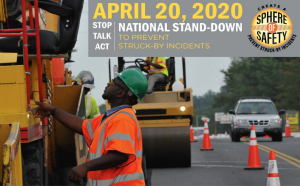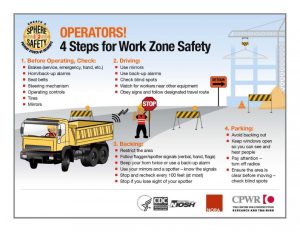Preventing Struck-by Injuries in Construction
Posted on by
Struck-by injuries are the leading cause of nonfatal injuries and the second most common cause of fatalities among construction workers (1), costing over $1.7 billion in workers compensation costs in 2016 (2). These injuries occur when a worker is struck by a moving vehicle, equipment, or by a falling or flying object, (3). For construction workers, the risk of nonfatal struck-by injuries is twice the risk of all other industries combined, and construction workers have the highest number of fatal struck-by injuries compared to any other industry (4). Employers and employees can work together to raise awareness and prevent struck-by injuries.
National Stand-Down to Prevent Struck-by Incidents in Construction
 During the April 2020 National Work Zone Awareness Week, the NORA Construction Sector Council co-hosted the first annual National Stand-Down to Prevent Struck-by Incidents among construction workers (5). This stand-down was modelled after the success of the National Campaign to Prevent Falls in Construction and the Annual National Stand-Down. The National Stand-Down to Prevent Struck-by Incidents provided an opportunity for construction employers, contractors, and workers to pause and focus on evidence-based methods for preventing struck-by incidents. In partnership with CPWR– the Center for Construction Research and Training, NIOSH presented a live question and answer session, moderated by Brad Sant, Senior Vice President of the American Road & Transportation Builders Association, with panelists from NIOSH, the Laborers’ Health & Safety Fund of North America, a large construction company (Kraemer North America, LLC), and the Texas Department of Transportation. The session has been viewed over 1,600 times including over 650 live viewers, with over 200 questions submitted. A recording of the event is available here.
During the April 2020 National Work Zone Awareness Week, the NORA Construction Sector Council co-hosted the first annual National Stand-Down to Prevent Struck-by Incidents among construction workers (5). This stand-down was modelled after the success of the National Campaign to Prevent Falls in Construction and the Annual National Stand-Down. The National Stand-Down to Prevent Struck-by Incidents provided an opportunity for construction employers, contractors, and workers to pause and focus on evidence-based methods for preventing struck-by incidents. In partnership with CPWR– the Center for Construction Research and Training, NIOSH presented a live question and answer session, moderated by Brad Sant, Senior Vice President of the American Road & Transportation Builders Association, with panelists from NIOSH, the Laborers’ Health & Safety Fund of North America, a large construction company (Kraemer North America, LLC), and the Texas Department of Transportation. The session has been viewed over 1,600 times including over 650 live viewers, with over 200 questions submitted. A recording of the event is available here.
Which Struck-by Events Most Commonly Cause Nonfatal Injury?
Compared to all other industries, construction workers have the highest rate of nonfatal struck-by injuries at 2.7 per 10,000 Full-Time Equivalent (FTE) workers (4). The most common sources of nonfatal struck-by injuries involved solid building materials, powered and nonpowered hand tools, and scrap/waste/debris (4). The rate of nonfatal struck-by injuries is highest among helpers, sheet metal workers, heating and air conditioning mechanics, and ironworkers (see Figure 1). Most nonfatal struck-by injuries (96%) are caused by falling or flying objects, or equipment (4). The most common events leading to a non-fatal injury include being struck by handheld objects or equipment (36%), falling objects or equipment (29%), and discharged or flying objects (14%).

Which Struck-by Events Most Commonly Cause Fatal Injury?
Fatal struck-by injuries occur when a motor vehicle intrudes into a work zone or when construction vehicles and heavy equipment operate within a work zone. About half of fatal struck-by injuries were caused by a pedestrian being struck by a vehicle (384 fatalities or 48%, see Figure 2). In comparison to nonfatal injuries, about half of the non-work zone fatalities involve a falling object or equipment (51%) and 33% involve a powered vehicle non in transport (see Figure 2).

The construction workers building our nation’s highways and roads experience more of these tragic fatalities compared to other construction subsectors (4). About 1 in 10 construction worker fatalities are from work zone injuries. Of these work zone injuries, about half (50%) involve a pedestrian-vehicle incident, 13% are roadway incidents involving a motorized vehicle, and 10% involve an object or equipment. Construction crossing guards and paving/surfacing equipment operators had the highest rates of fatalities per 100,000 FTEs compared to all other Construction occupations (7).
What Can Employers and Workers Do to Prevent Struck-by Injuries?
Both employers and workers are responsible to do their part in reducing struck-by injuries. Scheduling pressures and lack of training can create barriers to focusing on prevention efforts (5). Employers can still participate by holding Toolbox Talks and displaying flyers around the jobsite, which are effective methods to educate fellow workers about struck-by injuries. Spread the word by sharing these resources on social media, in presentations, and in print.
OSHA offers training modules to reduce struck-by injuries as part of the Focus Four Fatal Injuries in construction. This training provides focused information and case studies of real-life fatalities, along with the relevant OSHA regulations on the four worst hazards that construction workers face: falls, struck-by, caught-in/between and electrocutions (8).
CPWR offers more detailed work practices and prevention methods to reduce the risk of struck-by injuries, by type of hazard (4). Use the following best practices to reduce the risk of struck-by injuries due to equipment and falling or flying objects:
- Ensure comprehensive training, including on the safe operation of power tools and equipment, and encourage earning appropriate certifications.
- Tether smaller tools to work belts to prevent dropped objects.
- Wear appropriate protective gear (safety glasses, hardhat, face shields, etc.).
- Use pedestrian walkways and exercise caution when working near heavy equipment.
- Inspect all tools and equipment before use.
- Use sequential triggers (instead of contact triggers) for nail guns.
- Never work under a load, especially during lifting.
- Secure all loads and lift evenly to prevent slipping.
In addition to the NIOSH resource on Building Safer Work Zones, CPWR also offers more detailed resources for avoiding struck-by injuries within work zones (7).
 Increase the visibility of workers and equipment.
Increase the visibility of workers and equipment.- Use positive barriers between workers and traffic.
- Employ prevention methods using vehicle technologies such as
- Driver warning systems
- Worker warning systems
- Speed reduction systems
- Rollover protection structures
- Seatbelts
- Raise awareness by training workers and holding regular toolbox talks on struck-by injury prevention.
It’s Your Turn!
Review and share the materials highlighted in this blog to build on the success of this year’s Stand-down to Prevent Struck-by Injuries in Construction and mark your calendars for next year’s Stand-down, April 26, 2021.
Share with us, we want to hear from you!
- How has your workplace raised awareness of struck-by injuries?
- Which resources do you find most helpful?
- What other information do you need to prevent struck-by injuries?
Christina Socias-Morales, DrPH, is a Research Epidemiologist in the NIOSH Office of Construction Safety and Health.
Scott Earnest, PhD, PE, CSP, is the Associate Director for Construction Safety and Health.
CAPT Alan Echt, DrPH, CIH, Senior Industrial Hygienist in the NIOSH Office of Construction Safety and Health (retired).
CDR Elizabeth Garza, MPH, CPH, is Assistant Coordinator for the Construction Sector in the NIOSH Office of Construction Safety and Health.
Scott Breloff, Ph.D. is a Biomedical Research Engineer in the NOISH Office of Construction Safety and Health.
Resources
- NIOSH Highway Work Zone Safety Topic Page
- NIOSH Construction Equipment Visibility Topic Page
- CPWR Infographics
- CPWR Work Zone Safety
- CPWR Toolbox talks for workers
- CPWR Toolbox talks for vehicle operators
- NIOSH Fatality Assessment and Control Evaluation Reports
- OSHA Focus Four Training
- OSHA Struck-by Main Page
- The Dropped Object Experiment
References
- The Construction Chart Book. 6th Edition. The Center for Construction Research and Training (CPWR). 2018. Charts 43c and 43d Available from: https://www.cpwr.com/wp-content/uploads/publications/The_6th_Edition_Construction_eChart_Book.pdf
- Safety Index for the Construction Industry. Liberty Mutual Insurance. 2019. https://business.libertymutualgroup.com/business-insurance/Documents/Services/RC2029.pdf
- Department of Labor, Bureau of Labor Statistics (BLS). Occupational Injury and Illness Classification System V2.01 (2011-2019) Event or Exposure: Struck by object or equipment (62*) and Pedestrian Vehicular Incident (24*).
- CPWR Quarterly Data Report. Struck-by Injuries and Prevention in the Construction Industry. Second Quarter 2017. Available from: https://www.cpwr.com/sites/default/files/publications/Quarter2-QDR-2017.pdf
- BLS. Occupational Injuries and Illnesses and Fatal Injuries Profiles. Number of nonfatal occupational injuries and illnesses involving days away from work by selected worker and case characteristics and event or exposure, Struck by object or equipment (code 62XXXX), All U.S., private industry, 2011 – 2015. Available from: https://data.bls.gov/gqt/InitialPage
- CPWR. National Stand-down to Prevent Struck-by Incidents. April 20, 2020. Available from: https://www.cpwr.com/wp-content/uploads/publications/National-Struck-by-Stand-Down-PPT-final.pdf
- CPWR. Fatal Injuries at Road Construction Sites among Construction Workers. 2018 Available from: https://www.cpwr.com/wp-content/uploads/publications/publications_Quarter2-QDR-2018.pdf
- Department of Labor. Occupational Safety and Health Administration. Construction Focus Four Outreach Training Program. Available from: https://www.osha.gov/dte/outreach/construction/focus_four/
Posted on by

